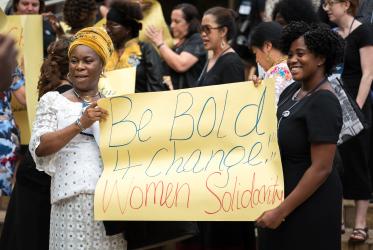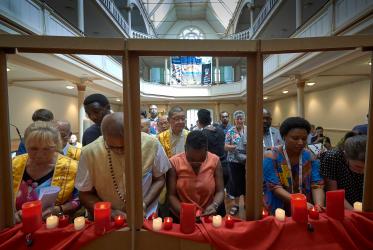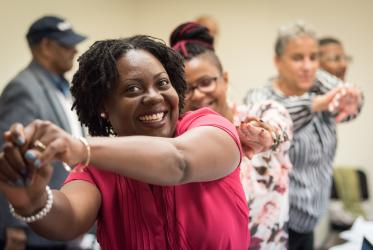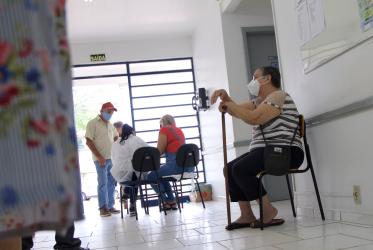By Dorothy Kweyu*
When 505 percent more girls than boys get infected with HIV, the virus that is in its fourth decade can, indeed, be said to wear a woman’s face.
The sobering statistic defines South Africa’s situation where, in 2013, more that 860 girls became infected with HIV every week, compared to 170 boys. The situation is grim, with statistics showing that, in Uganda, for instance, 70 percent of new infections are among young people, 62 percent of whom have sex before they turn 18.
Amid this stark reality, participants in a recent intergenerational consultation on HIV held 25-27 November decided to take the bull by the horns to address the pandemic that has become the leading cause of death for adolescents in sub-Sahara Africa.
Convened by the Ecumenical HIV and AIDS Initiatives and Advocacy (EHAIA) programme of the World Council of Churches (WCC-EHAIA), the talks in Limuru, Kenya, brought together 45 participants ages 12 to 73 years from 12 African countries. The idea was to create an intergenerational safe space for church leaders to engage with adolescents and young people on the subject of sex and sexuality in relation to HIV and AIDS and sexual gender-based violence (SGBV).
An objective of the three-day consultation was for churches to acknowledge the urgency and importance of involving adolescents (10-19 years) and youth (15-24) in ending new infections and preventing SGBV. Therefore, jointly with the young participants, church leaders drafted sample action plans for use by them and their schools is promoting HIV prevention, comprehensive sexual education and information for adolescents and young people.
An important group activity involved defining spheres of influence that can be used to reach the project goals. Drawn from Angola, the Democratic Republic of Congo, Ethiopia, Ghana, Kenya, Malawi, Nigeria, Rwanda, Tanzania, Uganda, Zambia and Zimbabwe, the participants had to contend with the fact that issues such as environmental degradation are taking precedence—and funding—away from HIV and AIDS. And yet, stemming the pandemic is not all about cash.
In an interview with WCC-EHAIA Program Executive Rev. Dr Nyambura Njoroge, she singled out the family as one place that does not need a cent to impart comprehensive sexual education and information to adolescents and young people. Njoroge viewed the family as “the first place where we all belong” and hence a space that can be used to influence young people’s decisions regarding their sex and sexuality. “When I’m in my family, I don’t need any extra dollar to influence people in that space.”
By placing the family in the vanguard of the HIV and AIDS response, Dr Njoroge was tacitly acknowledging the reality of rampant sex abuse within homes. During sessions on naming issues affecting children, adolescents and young people, which occupied a big chunk of the three-day programme, participants determined that homes were potentially safe havens and danger zones for young people.
A Nigerian lecturer gave the example of a student, who was always sleepy in class, only to turn out that her stepfather routinely raped her at night. And an HIV-positive student from Malawi narrated how she ran away from home to escape hunger and overwork inflicted on her in the blended family before her biological father found out what was happening and brought her back home.
In the Nigerian case, the girl’s biological mother had to be found and prevailed upon to take ownership of her sexually-abused child. In both cases, the family space proved to be the place where abuses against young people were perpetrated and also where solutions to the abused children’s plight lay.
A devastating case discussed at the talks involved an HIV-positive nine-year-old girl with multiple sexual partners. “In such situations, we really want to know what happened in that home. What is she looking for? Once we understand the problem, we can begin to say what are the solutions,” Dr Njoroge said.
Christian Health Association of Kenya (CHAK) official Tabitha Rono told participants about their initiative, which trains health workers to deal with adolescents and children, particularly those living with HIV. Although health workers may not deal with minors without parental consent, CHAK is consulting with the government and relevant ministries to allow HIV testing of sexually-active minors.
CHAK is an affiliate of the 26-member African Christian Health Associations Platform (ACHAP) with headquarters at the CHAK offices in Nairobi, Kenya. The umbrella organisation, whose creation was co-facilitated by the WCC and officially registered in Kenya in 2012 brings together members to do advocacy on health matters and learn from each other.
The consultation broke intergenerational barriers among the participants. Asked what he had learned from interacting with adults and fellow youth, David Mombo, who just finished high school said: “I now can speak to an audience on sex and sexuality without being shy like I was previously.”
Related news:
Overcoming discrimination to address HIV in Zimbabwe
Church activists address HIV and AIDS in Kenya
Church leaders in Ivory Coast raise awareness about sexuality, violence and HIV
Trying new ways that can save lives from HIV and AIDS
WCC group evaluates ecumenical HIV and AIDS response
WCC considers AIDS report a “valuable tool”
Churches need to do more to tackle HIV and AIDS
*Ms Kweyu is a Nairobi-based freelance journalist and editorial consultant.







